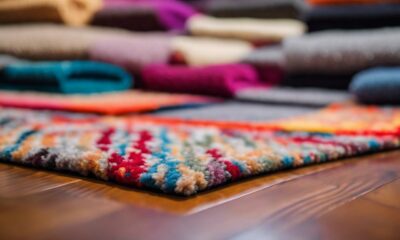Mattress Pads
Why Does My Sunbeam Heated Mattress Pad Beep
Open the door to uncover the mystery behind why your Sunbeam heated mattress pad beeps intermittently – find the answer within!

If your Sunbeam heated mattress pad is emitting beeping sounds, there could be a number of reasons behind it, such as control system malfunctions or problems with temperature regulation. Make sure all connections are properly plugged in and check for any error codes like F1 or F7 for troubleshooting tips. Test the power cord, control panel settings, and internal components. Look into possible component failures like the control module, sensors, or wiring. If necessary, follow manufacturer instructions to replace any faulty heating elements. For further information on effectively addressing the beeping problem, refer to the detailed steps provided.
Key Takeaways
- Check for proper connections to ensure correct orientation and alignment of cords.
- Understand error codes like F1 for thermistor issues or F7 for keypad problems.
- Troubleshoot heating functionality by verifying power source and control panel settings.
- Identify component failures such as control module, sensors, or wiring issues.
- Replace faulty heating elements following manufacturer's instructions or seek customer support.
Possible Reasons for Beeping
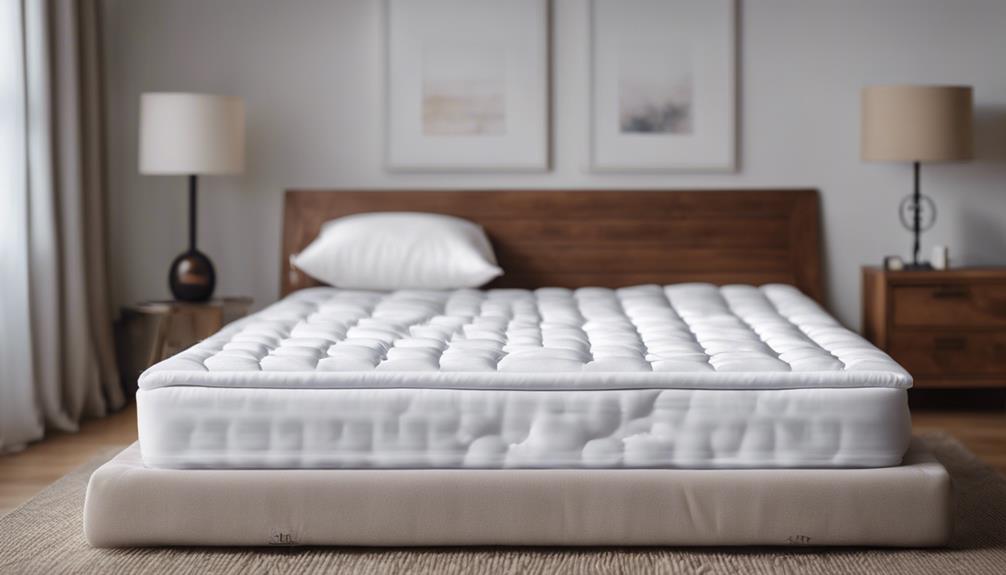
When troubleshooting the Sunbeam Heated Mattress Pad beeping issue, we often find ourselves examining various possible reasons for the persistent sound. The beeping could stem from a malfunction in the control system, indicating an error code related to temperature regulation or sensor issues.
Sometimes, continuous beeping may signal a problem with the heating elements or internal components of the pad. Users have reported instances where the pad beeps when it fails to heat properly or encounters connectivity issues.
It's important to address these issues promptly to guarantee the efficient functioning of the Sunbeam heated mattress pad. If the beeping persists despite troubleshooting attempts, reaching out to customer support for warranty assistance is advisable.
Checking for Proper Connections
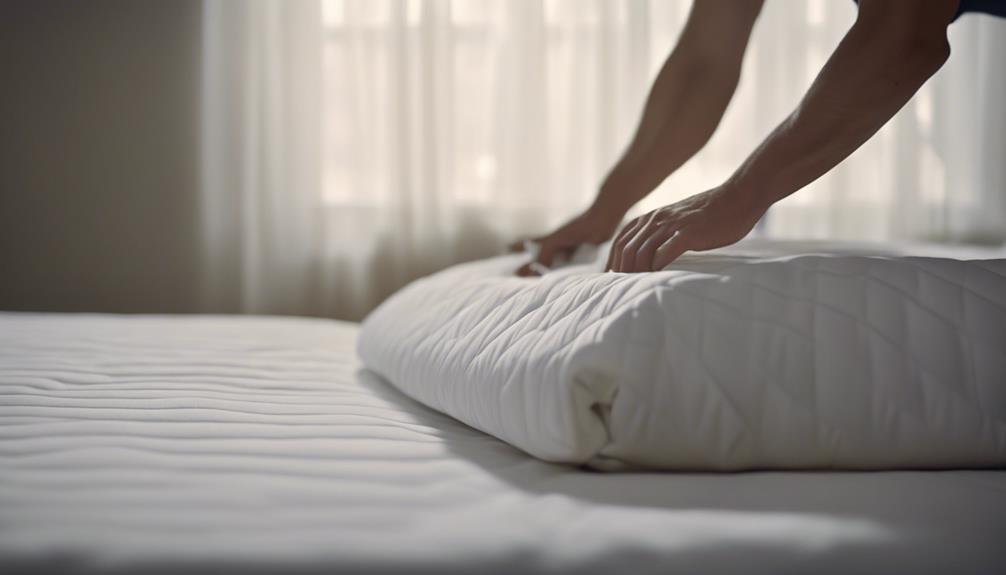
To address the beeping issue with the Sunbeam Heated Mattress Pad, make sure all connections are properly unplugged and then reconnected in the correct orientation. When troubleshooting the beeping problem, it's vital to pay attention to the details of reconnecting the cords.
Confirm that the connectors are aligned correctly to the corresponding outlets on the mattress pad and power source. After reconnection, observe for any blinking lights on the control unit. The lights should blink twice and then stop, indicating that the reconnection was successful.
By following these steps and guaranteeing proper reconnection of the connections, you should be able to resolve the beeping matter with your Sunbeam heated mattress pad.
Properly reconnecting the cords is a fundamental step in troubleshooting various issues, including the beeping sound. Take the time to double-check the orientation and secure connection of each plug to enjoy a peaceful night's sleep without any disruptive beeping noises.
Understanding Error Codes
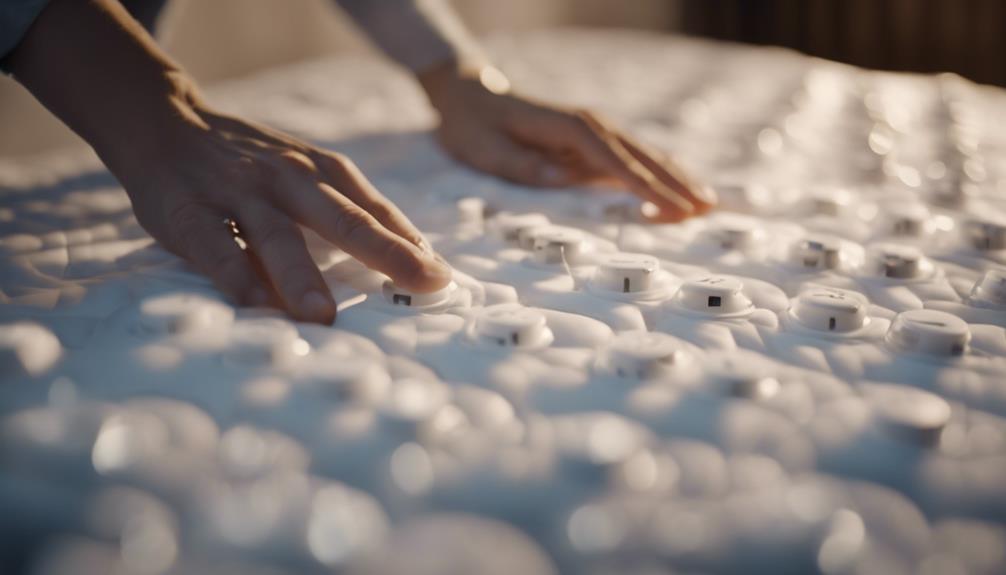
When your Sunbeam heated mattress pad starts beeping, it's important to pay attention to the error codes displayed. These codes, like F1 or F7, can provide valuable insights into what might be causing the beeping.
Error Code Meanings
Understanding the meaning of error codes, such as F1 and F7 on Sunbeam heated mattress pads, is crucial for diagnosing and resolving specific issues effectively. When encountering these codes, it's important to know their implications:
- F1 Error: Indicates a malfunction in the thermistor control, impacting the heating functionality.
- F7 Error: Points to a problem with the keypad or control panel, affecting the overall operation.
Proper identification of these error codes enables targeted troubleshooting and resolution.
Familiarizing oneself with these error code meanings can guide users in addressing beeping or malfunctioning Sunbeam heated mattress pads promptly.
Troubleshooting Steps
Let's explore the steps for troubleshooting Sunbeam heated mattress pads by deciphering the error codes.
When dealing with a beeping issue, it's essential to understand the error codes displayed on the Sunbeam heated mattress pad.
Common codes like F1 for a failed thermistor control or F7 for a faulty keypad can provide insights into the underlying problems affecting the heating functionality.
By identifying these error codes, you can take specific troubleshooting steps to address issues such as fan problems, stuck buttons, or a malfunctioning element.
Troubleshooting Heating Functionality
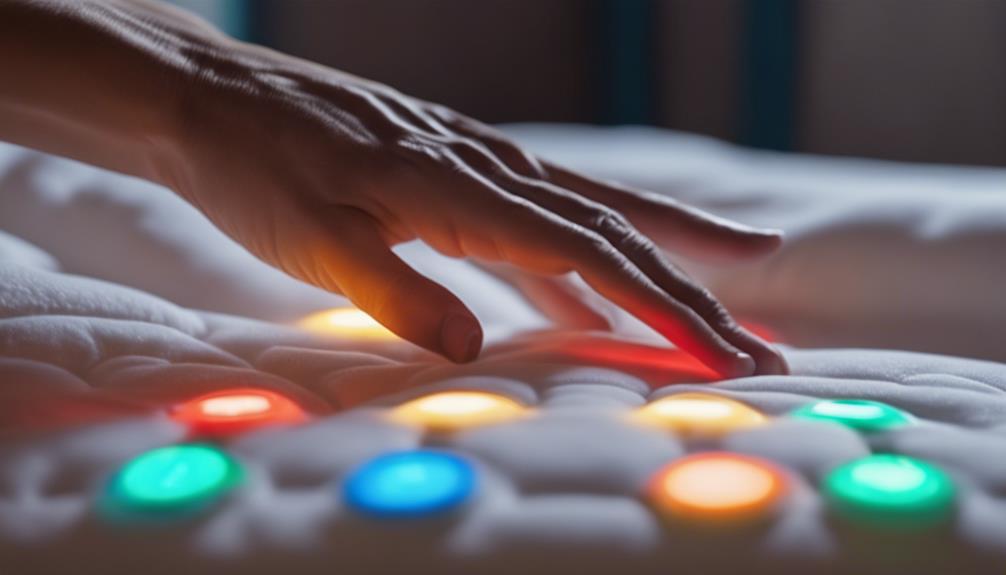
To troubleshoot issues with the heating functionality of a Sunbeam heated mattress pad, start by checking the connection, control panel, and power source.
- Confirm the power cord is securely plugged into both the mattress pad and the outlet.
- Verify that the control panel settings are correct and not causing the beeping.
- Test the power source by plugging another device into the same outlet to rule out electrical issues.
- If the beeping persists, it may indicate internal component failures requiring professional repair.
If simple solutions like repositioning the pad or adjusting settings don't resolve the beeping, it's essential to contact Sunbeam customer support for further assistance. They can provide guidance on potential causes of the issue and recommend next steps for troubleshooting or repair. Remember, addressing heating malfunctions promptly can help maintain the comfort and functionality of your heated mattress pad.
Identifying Component Failures
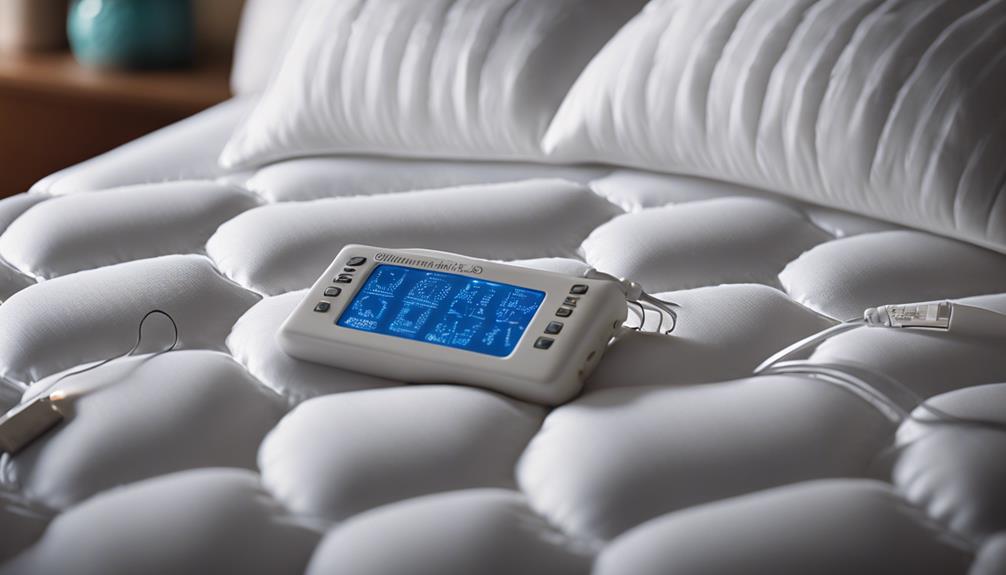
When troubleshooting a Sunbeam heated mattress pad that is beeping, identifying component failures is essential for effective resolution. Common issues that may cause the mattress pad to beep include problems with the control module, temperature sensors, faulty wiring, or connectors. To pinpoint the exact cause of the beeping, it is advisable to refer to the user manual for error code explanations specific to your Sunbeam heated mattress pad model. Understanding these error codes can help in diagnosing which component is experiencing a failure.
| Component | Possible Failure Causes | Resolution |
|---|---|---|
| Control Module | Malfunction or programming error | Reset the control module |
| Temperature Sensors | Defective sensors or wiring | Check and replace sensors |
| Faulty Wiring | Wiring damage or connection issues | Inspect and repair wiring |
If troubleshooting the component failures on your Sunbeam heated mattress pad becomes challenging, reaching out to Sunbeam's customer support for expert assistance and guidance is highly recommended. They can provide further troubleshooting steps or advise on the next best course of action.
Replacing Faulty Elements
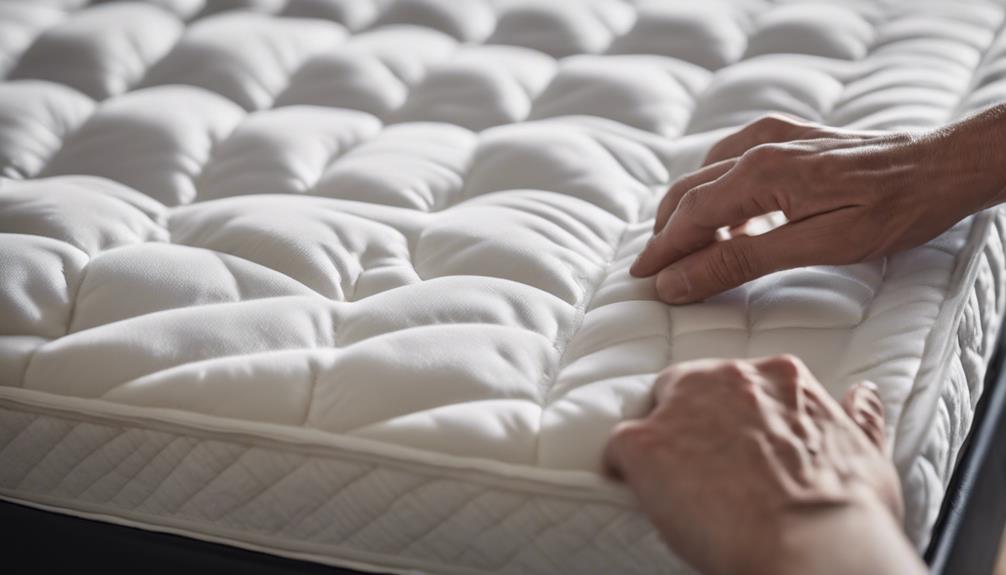
Identifying component failures in a Sunbeam heated mattress pad that's beeping may lead to the necessity of replacing faulty elements to resolve the issue effectively. When dealing with a beeping heated mattress pad, it's important to address the malfunction promptly.
Here's how you can go about replacing faulty elements:
- Locate the specific faulty heating element: Pinpointing the exact element causing the beeping is essential for targeted replacement.
- Refer to manufacturer's instructions: Follow the guidelines provided by the manufacturer to make sure the correct replacement process.
- Contact customer support: If you're unsure about the replacement procedure, reaching out to customer support can provide valuable assistance.
- Resolve the issue: By replacing the faulty elements according to the manufacturer's instructions, you can effectively fix the beeping problem in your Sunbeam heated mattress pad.
Final Steps and Recommendations
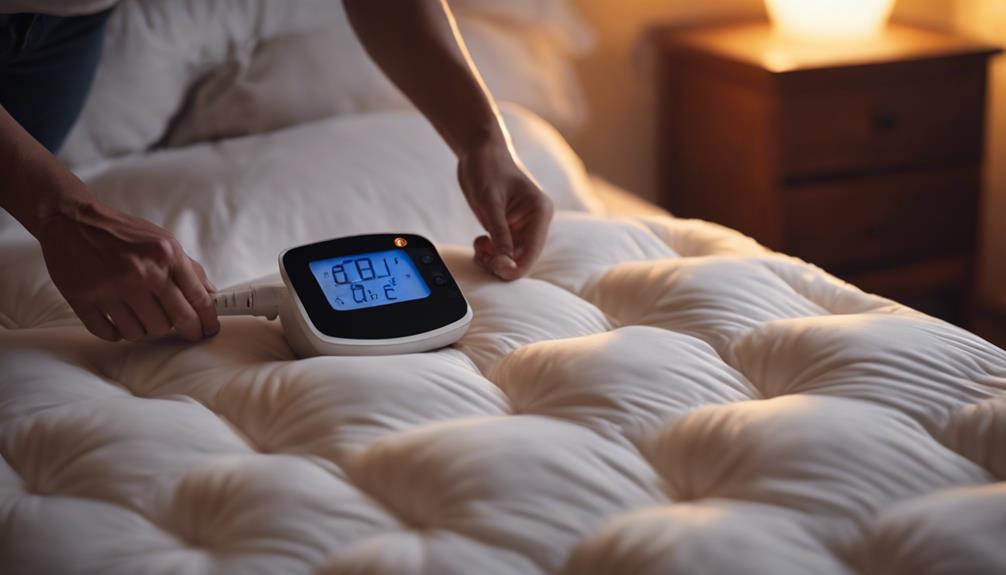
Let's wrap up our troubleshooting process with the final steps and recommendations for resolving the beeping issue in a Sunbeam heated mattress pad.
If you've encountered persistent beeping, it's vital to contact Sunbeam's customer support for expert assistance. They can provide valuable guidance tailored to your specific situation and help determine if warranty coverage applies to address any potential malfunctions or errors causing the beeping.
Before reaching out, double-check the orientation of connectors and the power source to make sure everything is correctly set up. Sometimes, a simple adjustment can rectify the issue and stop the beeping.
If the problem persists even after troubleshooting and reaching out to customer support, it may indicate a more significant malfunction that requires professional inspection or repair.
Frequently Asked Questions
How Do I Reset My Sunbeam Heated Mattress Pad?
To reset your Sunbeam heated mattress pad, follow these steps:
- Unplug it from the wall outlet.
- Check the control and module connection for any loose parts.
- Plug it back in and watch for troubleshooting symbols on the digital control.
If the issue persists after these steps, contact Sunbeam for repair or replacement assistance. It's important to note that your Sunbeam pad may not feel hot when flat, which is normal.
Why Is the Light Blinking on My Sunbeam Heated Mattress Pad?
When the light blinks on a Sunbeam heated mattress pad, it might point to a connection issue between the control and module. Re-plugging the power cord can reset the pad, stopping the blinking symbols on the digital control.
If this doesn't work, reaching out to Sunbeam for repair or replacement is recommended. Remember, Sunbeam products may not feel hot when laid flat due to their design, so troubleshooting steps can help address the beeping or blinking light concern.
How to Fix Sunbeam Heating Pad?
To fix a Sunbeam heating pad, follow these steps:
- Unplug all connections and check proper orientation when reconnecting.
- The control panel lights should blink twice and then stop after reconnection.
- If done correctly, the beeping issue should cease.
If problems persist, seek support from Sunbeam. Remember, proper troubleshooting can resolve most issues, but don't hesitate to reach out for help if needed.
How Do I Reset My Electric Heating Pad?
To reset an electric heating pad, unplug the power cord, check for loose connections, and reconnect it.
Watch for flashing symbols on the digital control for troubleshooting. If the issue persists, contact customer support for further assistance.
Sunbeam products may not feel hot when laid flat due to their design. Remember, safety first when dealing with electrical appliances.
Conclusion
To sum up, if your Sunbeam heated mattress pad is beeping, don't worry – there are simple steps you can take to troubleshoot the issue.
By checking connections, understanding error codes, and identifying potential component failures, you can get to the root of the problem and resolve it quickly.
Remember, a little patience and persistence can go a long way in ensuring a cozy and uninterrupted night's sleep.
Stay vigilant and rest easy!
Mattress Pads
What Does Preheat Do on Heated Mattress Pad
Transform your bedtime routine with preheating on a heated mattress pad, ensuring a cozy and warm bed for a perfect night's sleep.
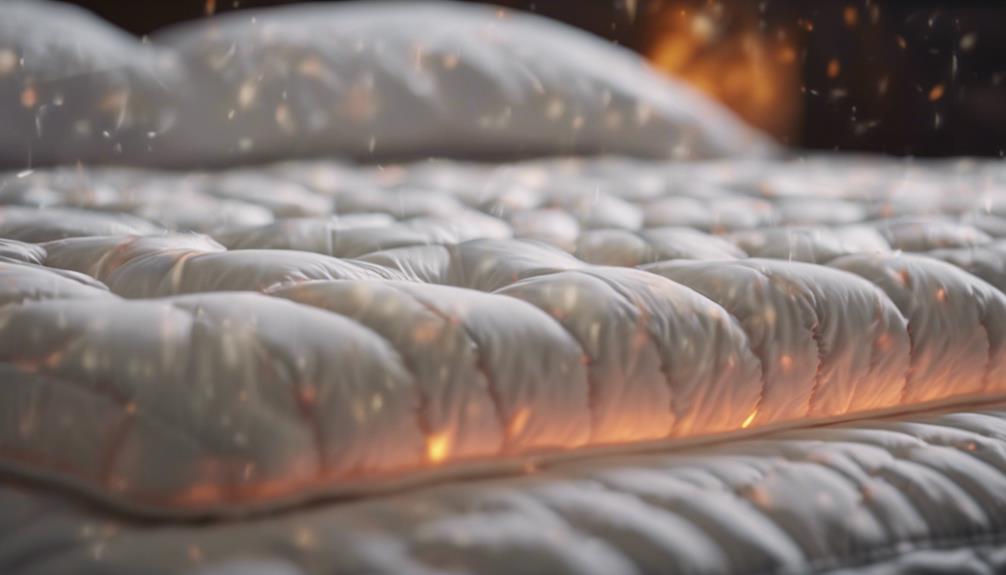
Preheating with a heated mattress pad ensures a warm and cozy bedtime experience by warming up the bed before you go to sleep. This not only creates a comfortable environment for relaxation but also helps improve the quality of your sleep. The preheating function can be set for up to 30 minutes, guaranteeing a cozy and warm bed. Some models even have the option to revert to previous settings or automatically switch off. This feature seamlessly fits into bedtime routines and allows for customization through digital controls. Users can enjoy the convenience of presetting bed warming and conserve energy at the same time. By setting the ideal preheat temperature, you can ensure customized comfort and enhance your bedtime experience. Remember to follow tips for safe use, such as monitoring the preheat time and selecting the right temperature.
Key Takeaways
- Enhances bedtime experience by ensuring a warm and inviting bed.
- Facilitates bedtime preparation with customizable settings and digital controls.
- Saves energy by activating for up to 30 minutes before reverting to previous settings.
- Promotes comfort with ideal preheat temperature for tailored warmth.
- Contributes to safety by monitoring preheat time, temperature selection, and proper insulation.
Benefits of Preheating on Mattress Pad

Why does preheating on a heated mattress pad offer such significant benefits?
The preheat function on a heated mattress pad provides numerous advantages that enhance our bedtime experience.
First and foremost, it offers convenience and comfort by guaranteeing the bed is warm and inviting when it's time to retire for the night.
This feature helps in bedtime preparation, creating a cozy environment that promotes relaxation and better sleep quality.
The ability to preset bed warming using digital controls adds to the convenience, allowing users to customize their experience according to their preferences.
Additionally, the energy-saving aspect of the preheat function is remarkable, as it automatically returns to previous settings or switches off after the preheating period, helping to conserve energy.
How Preheat Function Works
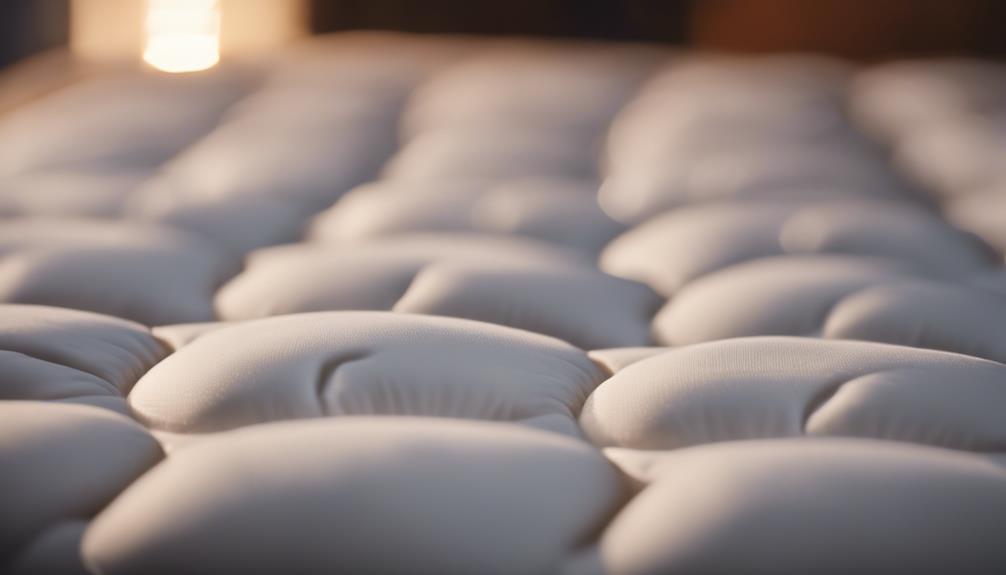
The preheat function on a heated mattress pad activates to warm the bed for up to 30 minutes at a selected temperature. This feature guarantees that your bed is cozy and warm, providing a welcoming retreat for a restful night's sleep.
After the preheating period, the control on the mattress pad either reverts to the previous setting or switches off if it was set to Off. Some models with digital controls offer the convenience of presetting the bed warming at specific times, seamlessly integrating this cozy feature into your bedtime routine.
Ideal Preheat Temperature
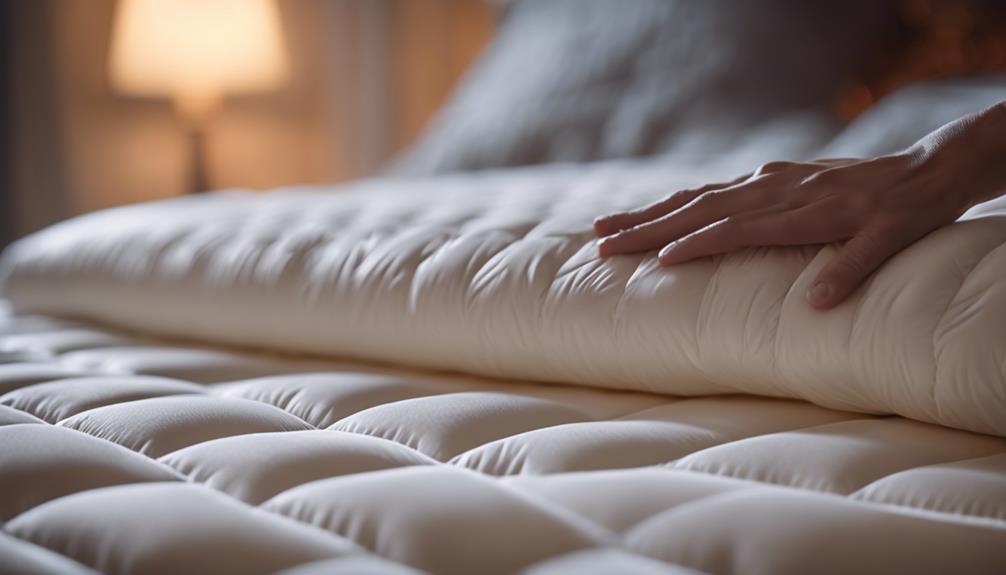
Shifting from discussing how the preheat function works on a heated mattress pad, let's now explore the ideal preheat temperature for maximizing bedtime comfort. When setting up the preheat function on your heated mattress pad, it's crucial to choose the temperature that best suits your preferences. Here are some aspects to take into account:
- Customized Comfort: Selecting the right temperature guarantees that your bed feels just the way you like it, promoting a restful night's sleep.
- Instant Coziness: Preheating your mattress pad means stepping into a warm and inviting bed, creating a soothing environment for relaxation.
- Convenience at Your Fingertips: With the option to activate the preheat feature at specific times, you can come home to a perfectly warmed bed, ready for you to unwind.
- Tailored Warmth: Adjusting the preheat function to your desired warmth level ensures that you have a cozy and snug sleeping experience.
- Enhanced Bedtime Comfort: The preheat function guarantees that your bed is at the ideal temperature, helping you drift off comfortably and peacefully.
Setting Up Preheat Feature
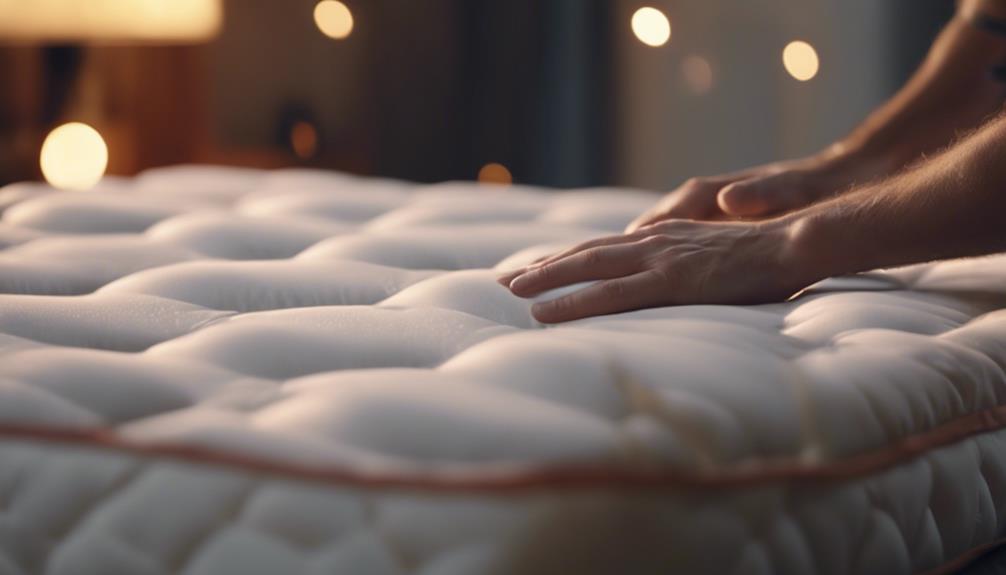
To set up the preheat feature on your heated mattress pad, simply select your desired temperature and enjoy a cozy bed in just 30 minutes. Electric mattress pads with digital controls make this process easy and convenient.
By utilizing the preheat function, you can enhance your bedtime preparation routine by ensuring a warm and cozy bed awaits you when you're ready to sleep. This feature not only creates a comfortable sleep environment but also allows you to customize the settings to suit your individual preferences.
Whether you prefer a toasty warm bed or a subtle heat to take the chill off, the preheat function on your heated mattress pad can cater to your needs. With just a few simple adjustments on the digital controls, you can transform your bed into a warm and inviting haven, setting the stage for a restful night's sleep.
Tips for Using Preheat Safely
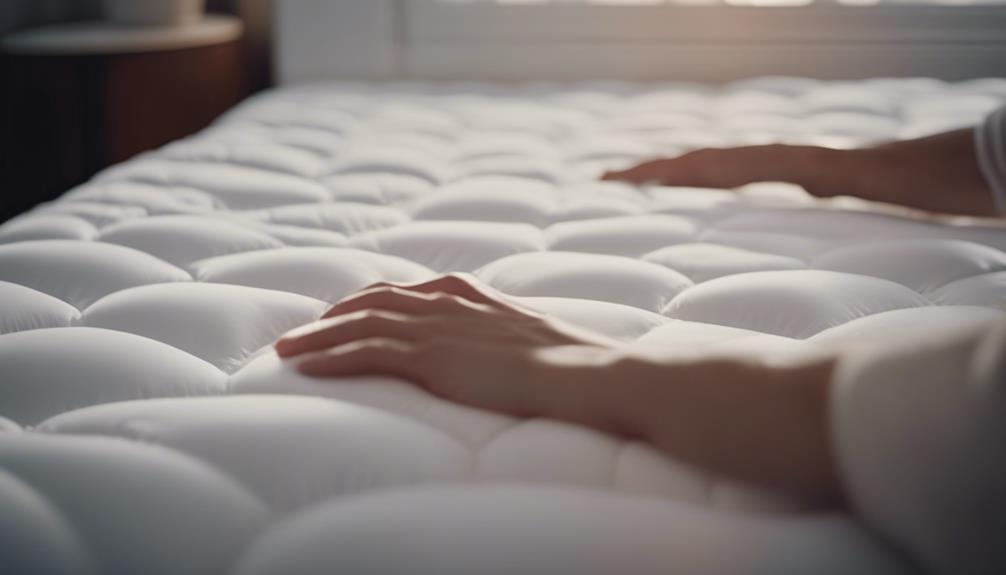
When using the preheat function on a heated mattress pad, remember to adjust the temperature gradually to prevent discomfort or overheating. Here are some tips for using the preheat function safely:
- Monitor the preheat time: Be mindful of the 30-minute preheating duration to avoid prolonged exposure to high temperatures.
- Select the right temperature: Choose a comfortable and cozy setting that will warm your bed effectively without making it too hot.
- Use digital controls wisely: Familiarize yourself with the controls to set the preheat function accurately and safely.
- Ensure proper insulation: Place the heated mattress pad under your sheets or mattress protector for effective heat distribution.
- Enjoy a warm and comfortable sleep: By following these tips, you can create a cozy and inviting sleep environment without compromising safety.
Frequently Asked Questions
What Does Preheat Mean on a Heated Blanket?
Preheat on a heated blanket guarantees the bed warms up before bedtime, providing a cozy environment for rest. It operates for up to 30 minutes at a set temperature, enhancing bedtime preparation.
Some controls allow presetting warming times for convenience. After preheating, the control reverts to the prior setting or shuts off. This function guarantees a warm start to your night's sleep, promoting comfort and relaxation.
How Long Does It Take for a Heated Mattress Pad to Heat Up?
It typically takes 10-15 minutes for a heated mattress pad to preheat to the desired temperature. Preheating guarantees a warm and cozy bed before hopping in. This function saves time by warming up the bed in advance.
Some models offer customizable preheat times and temperatures for personalized comfort. Preheating helps us relax and unwind in a toasty bed for a restful night's sleep.
Is It Healthy to Sleep on a Heated Mattress Pad?
Sleeping on a heated mattress pad can be beneficial as it promotes better blood circulation, relaxes muscles, and provides relief for joint stiffness and arthritis.
The even heat distribution and customizable settings contribute to a more comfortable sleep environment. Low voltage technology guarantees safety without overheating.
Additionally, energy savings can be achieved by not heating the entire room. Overall, using a heated mattress pad can enhance sleep quality and well-being.
How Long to Preheat an Electric Blanket?
When preheating an electric blanket, the duration typically ranges from 15 to 30 minutes to achieve the desired warmth level. This time frame guarantees that the blanket is cozy and inviting once you're ready to snuggle in.
It's crucial to follow the manufacturer's recommendations for preheating to optimize comfort and safety. Adjusting the preheat time based on personal preferences and the specific blanket model can enhance your overall sleeping experience.
Conclusion
To sum up, preheating your heated mattress pad can provide a cozy and comfortable sleeping experience.
Did you know that using the preheat function for just 10-15 minutes before bedtime can save up to 15% on your energy bills?
This simple feature not only warms up your bed but also helps you save money in the long run.
So don't forget to take advantage of the preheat function for a better night's sleep and a lighter wallet!
Mason – Your Product Expert Mason is your go-to product expert, carefully selecting each item in our collection to ensure it meets your comfort, functionality, and style needs. With his attention to detail and commitment to quality, he ensures that every product we offer enhances your home experience.
Mattress Pads
Are Heated Mattress Pads a Fire Hazard
Inadequate use of heated mattress pads can pose fire hazards, learn how to prevent risks and ensure safe usage.

Heated mattress pads can pose a safety risk if not used correctly. Potential dangers include high temperatures, damage, overheating, and flammable surfaces. To ensure safety, it is important to follow safety guidelines, check for any damage, maintain appropriate heat levels, and supervise use around pets and children. Make sure cords are properly managed, pads are placed on firm surfaces, and bedding is compatible. When not in use, unplug and store the mattress pad safely, and regularly inspect it for wear and tear. It is crucial to strictly adhere to the manufacturer’s instructions for safe use. Taking preventive measures is key to ensuring safety. For more in-depth information on the risks and ways to mitigate them, additional details can be helpful.
Key Takeaways
- Heating elements can reach high temperatures, posing a fire risk.
- Malfunction due to damage or overheating can lead to fires.
- Proper supervision, inspection, and adherence to safety guidelines are crucial.
- Placing pads on flat, hard surfaces and avoiding flammable materials is important.
- Regular monitoring of temperature settings and maintenance can prevent fire hazards.
Potential Risks of Heated Mattress Pads

Heated mattress pads present a potential fire hazard if not used correctly. The heating elements in these pads can reach high temperatures, and if they malfunction due to damage or overheating, a fire risk can arise. To guarantee blanket safety, it's vital to regularly inspect the pad for any frayed wires or signs of wear. Monitoring the temperature settings is also important to prevent overheating. Additionally, avoiding exposure to water is crucial as moisture can damage the wiring and increase the risk of fire.
Proper usage of heated mattress pads involves following the manufacturer's instructions diligently. Using a timer to control the duration of heating and supervising its use can greatly reduce the chances of a fire starting. In addition, maintaining the pad well, storing it properly, and placing it on a flat, hard surface can further minimize the fire risk associated with these heating devices. By adhering to these safety measures, the potential fire hazards of heated mattress pads can be effectively mitigated.
Common Causes of Heated Mattress Pad Fires
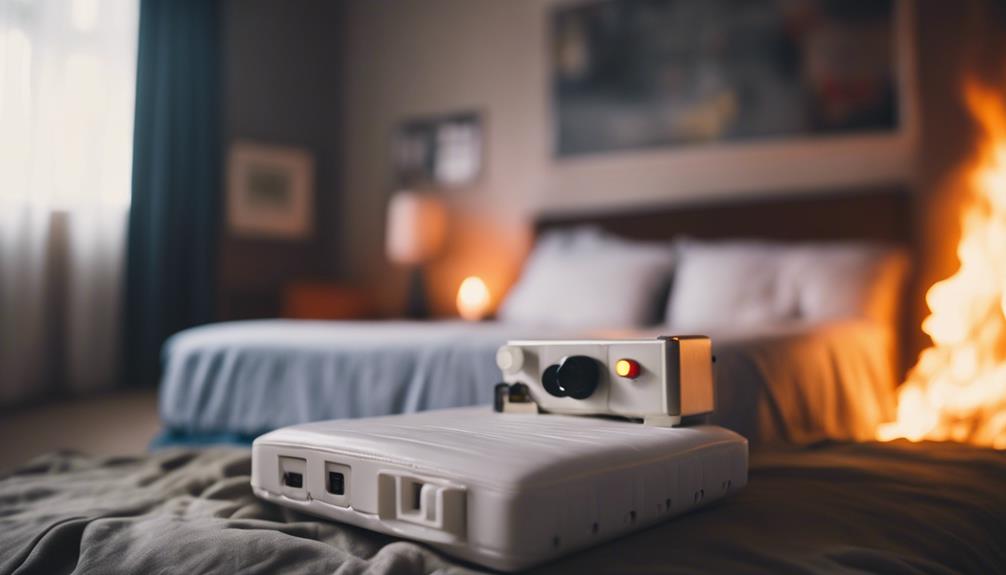
Commonly, overheating from extended use poses a significant risk for fires associated with heated mattress pads. Damage to the electrical components, such as frayed wires, can also lead to a fire hazard with heated mattress pads. Improper storage or misuse, like folding the pad while in use, can increase the risk of a fire breaking out. Additionally, using a heated mattress pad on flammable surfaces or covering it with other materials can contribute to fire incidents.
It's important to follow the manufacturer's instructions for safe use and maintenance to prevent heated mattress pad fires. By being mindful of these common causes, individuals can reduce the likelihood of encountering a fire hazard with their heated mattress pads. Regularly checking for any signs of wear and tear, avoiding improper storage practices, and ensuring the pad is used on a suitable surface are essential steps in preventing potential fire risks associated with heated mattress pads.
Safety Guidelines for Heated Mattress Pads

Following essential safety guidelines when using mattress pads is vital to prevent potential hazards. When it comes to heated mattress pads, ensuring safety is paramount. These pads are generally safe when used according to manufacturer guidelines. They come equipped with safety features like shut-off timers and monitoring technology, which greatly reduce fire risks. Unlike electric blankets, heated mattress pads are placed underneath sheets and contain water, making them safer to use.
To maintain safety, it's important to inspect the pad regularly for any signs of damage, such as frayed wires, which could pose a fire hazard. Proper usage, including following temperature control recommendations and ensuring supervision of children and pets around the heating pad, is essential for preventing accidents. By adhering to these safety guidelines, the risk of fire from a heated mattress pad can be greatly minimized, allowing for a cozy and safe sleep environment.
Importance of Supervision With Heated Mattress Pads

Proper supervision around heated mattress pads is essential to prevent potential fire hazards and guarantee safe usage. When it comes to using heated mattress pads, keeping a close eye on their operation is indispensable. This is particularly important when children or pets are around, as their curiosity could lead to accidents.
Monitoring the temperature settings and overall usage of heated mattress pads can help prevent overheating, reducing the risks of fire hazards. Additionally, supervising the use of these pads enables any issues or malfunctions to be identified and addressed promptly, ensuring continued safety.
Proper Placement of Heated Mattress Pads
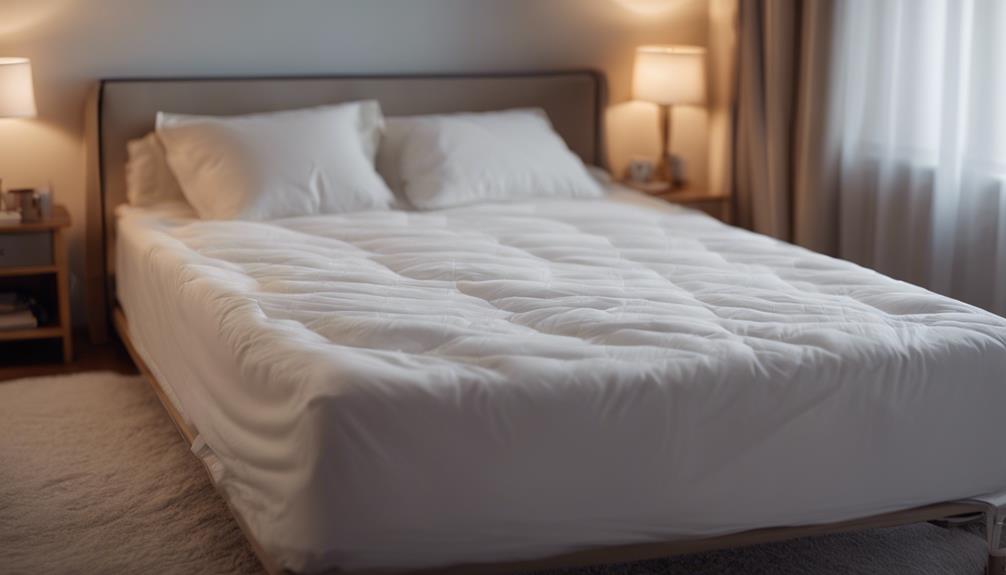
When setting up heated mattress pads, it's important to place them on flat, hard surfaces to minimize fire risks.
Proper cord management is vital to prevent entanglement and potential hazards.
Ensuring the compatibility of bedding materials with the heated pad is necessary for safe and effective use.
Safe Heating Pad Placement
We always recommend placing heated mattress pads on flat, hard surfaces to prevent overheating and fire hazards. Using the heating pad or electric blanket on soft surfaces like beds or couches can increase the risk of a potential fire.
It's important to keep flammable materials away from the heated mattress pads to guarantee safe usage. Additionally, proper placement of the heated mattress pads away from water sources is vital to prevent electrical accidents.
Remember to supervise children and pets around heated mattress pads to avoid potential burns or injuries. By following these guidelines for safe heating pad placement, you can enjoy the warmth and comfort they provide while minimizing the risk of fire hazards.
Cord Management Tips
How can we guarantee the safe and efficient management of the cords for heated mattress pads? Proper cord management is essential to prevent hazards and promote the longevity of the pad. Avoid running the cord under the mattress or bed frame as this can lead to overheating and fraying. Make sure the cord is not twisted or pinched to maintain wiring integrity and prevent fire risks. Utilize a cord management system to keep it organized and away from potential sources of damage. Regularly inspect the cord for any signs of wear, fraying, or damage to ensure safe usage of the heated mattress pad.
| Cord Management Tips |
|---|
| Avoid running cords under the mattress or bed frame |
| Use a cord management system to keep cords organized |
| Regularly check cords for signs of wear and damage |
Bedding Compatibility Requirements
To guarantee the safe and proper placement of heated mattress pads, it's essential to place them on a flat, hard surface to minimize fire hazards. When considering the compatibility of bedding with heated mattress pads, it's important to follow these guidelines:
- Heated mattress pads should be placed on a flat, hard surface to prevent fire hazards.
- Avoid using heated mattress pads on soft surfaces like beds or couches.
- Keep flammable materials away from heated mattress pads to reduce the risk of fires.
- Proper placement of heated mattress pads helps minimize fire risks associated with their use.
Following these recommendations ensures the safe and efficient use of heated mattress pads while reducing the potential for fire hazards.
Maintenance Tips to Prevent Fire Hazards

Regularly inspect your heated mattress pad for frayed wires or signs of damage to prevent fire hazards. Avoid using a wet or damaged heated mattress pad and make sure it is placed on a flat, hard surface away from flammable materials to reduce fire risks. It is important to supervise children and pets around the heated mattress pad to prevent accidents that could lead to fire hazards. Proper maintenance and storage of your heated mattress pad will not only extend its lifespan but also minimize the risk of fire. Here are some essential maintenance tips to prevent fire hazards:
| Maintenance Tips for Fire Prevention |
|---|
| Inspect for frayed wires or damage regularly |
| Avoid using wet or damaged pads |
| Place on a flat, hard surface away from flammable materials |
| Supervise children and pets around the pad |
Using Heated Mattress Pads at Safe Temperatures

Using heated mattress pads within the safe temperature range specified by the manufacturer is essential for preventing fire incidents. It's important to follow the recommended guidelines to guarantee the safety of using these pads.
- Pads safe: Adhering to the manufacturer's specified safe temperature range is essential for preventing fire hazards.
- Avoid overheating: Monitoring the temperature settings and avoiding excessive heat can greatly reduce the risk of fire incidents.
- Cause a fire: Failure to control the temperature of heated mattress pads can lead to potential fire hazards.
- Follow instructions: It's vital to follow the instructions provided with the heated mattress pad to maintain safe temperature levels and prevent fires.
Fire Prevention Measures for Heated Mattress Pads

Regularly inspect your heated mattress pad for wear and damage to prevent fire hazards. Keep the pad away from water sources, unplug when not in use, and follow manufacturer's guidelines to reduce fire risks.
Supervise children and pets around the pad to prevent tampering with cords or settings.
Safety Guidelines for Pads
To guarantee the safe use of heated mattress pads and prevent fire hazards, it's essential to inspect them regularly for frayed wires or damage. Unplug the pad when not in use to reduce the risk of electrical fires. Avoid covering or folding the pad while in use to prevent overheating and potential fire risks. Follow the manufacturer's instructions for safe use, including proper placement on flat, hard surfaces away from flammable materials. Remember to supervise children and pets around heated mattress pads to prevent accidents and fire hazards.
- Inspect pads regularly for frayed wires or damage.
- Unplug pads when not in use to reduce the risk of electrical fires.
- Avoid covering or folding pads while in use to prevent overheating.
- Follow manufacturer's instructions for safe use, including proper placement.
Usage Recommendations for Pads
When using heated mattress pads as a fire prevention measure, always adhere to the manufacturer's safety guidelines. Following these instructions is essential for ensuring the safety of your household.
Supervise children and pets around the pads to prevent accidents and injuries. It's important to avoid placing the heated mattress pads on soft surfaces or near flammable materials to reduce fire risks.
Utilize the temperature controls on the pads to prevent burns and overheating. Remember to unplug and store the heated mattress pads safely when not in use, as this simple step can greatly reduce the chances of a fire hazard.
Prioritizing these safety measures will help you enjoy the benefits of heated mattress pads without compromising on safety.
Monitoring Heat Levels
Proper monitoring of heat levels in heated mattress pads is crucial for preventing fire incidents and ensuring household safety. When it comes to heating equipment, staying vigilant about heat levels can greatly reduce fire risks.
To achieve this, consider the following:
- Regularly check the temperature settings on your heated mattress pad.
- Ensure that the pad is properly maintained and free from any damage.
- Monitor the pad while in use to confirm it's functioning correctly.
- Familiarize yourself with the manufacturer's guidelines for safe operation.
Frequently Asked Questions
Do Heated Mattress Pads Catch Fire?
Heated mattress pads rarely catch fire when used correctly. Safety features like shut-off timers prevent overheating, reducing fire risk. Proper maintenance, such as inspecting for damage and following guidelines, further enhances safety.
While all electrical products pose some fire risk, heated mattress pads are generally safe. Regular checks and adherence to usage instructions are key in minimizing any potential hazards.
Is It Safe to Leave a Heated Mattress Pad on All Night?
Leaving a heated mattress pad on all night can pose a fire hazard due to overheating. Continuous use can lead to potential safety risks and increase the likelihood of fires.
Safety guidelines recommend against leaving heated mattress pads on while sleeping for prolonged periods. Overheating from prolonged use can damage the mattress pad and increase the risk of fire.
To reduce fire hazards, it's advisable to use a heated mattress pad only while awake and monitoring its operation.
How Likely Is a Heating Pad to Start a Fire?
Heating pads pose a fire risk if misused or left unattended. It's important to inspect them for any signs of damage regularly.
Turning off and unplugging before sleeping reduces the likelihood of fire incidents. Avoid using extension cords with heating pads, as they can overheat.
Proper maintenance and following safety guidelines greatly decrease the chances of a heating pad starting a fire. Regular checks and safe practices are key in fire prevention.
Is Leaving Heating Pad Plugged in Fire Hazard?
Leaving a heating pad plugged in when not in use can indeed pose a fire hazard. Over 500 home fires are caused annually by improper use of heating pads and electric blankets. To prevent potential fire incidents, it's essential to unplug heating pads when not in use.
Fire risks associated with heating pads include frayed wires, overheating, and improper storage. Following safety guidelines and manufacturer instructions can help reduce the fire hazard potential of heating pads.
Conclusion
To sum up, while heated mattress pads can provide warmth and comfort during the cold winter months, it's important to be aware of the potential fire hazards they pose. By following safety guidelines, practicing proper maintenance, and using them at safe temperatures, the risks can be minimized.
It's essential to stay vigilant and take precautions to guarantee the safety of yourself and your loved ones when using heated mattress pads.
Mason – Your Product Expert Mason is your go-to product expert, carefully selecting each item in our collection to ensure it meets your comfort, functionality, and style needs. With his attention to detail and commitment to quality, he ensures that every product we offer enhances your home experience.
Mattress Pads
Can I Wash My Heated Mattress Pad
Discover the essential steps to safely wash your heated mattress pad for longevity and comfort.

When you wash your heated mattress pad, make sure to first disconnect the controller and electrical parts. Use a gentle cycle with cold water, avoid bleach, and air dry or tumble on low. Detach the electric cord to prevent hazards and keep it dry. Choose a mild detergent suitable for delicate fabrics. Wash the pad separately to maintain its lifespan. Air dry in a well-ventilated area to avoid damage. Adhering to manufacturer’s instructions is crucial for longevity and safety. Regular cleaning ensures a hygienic sleep environment. Following these tips will help effectively maintain your heated mattress pad.
Key Takeaways
- Disconnect electrical components before washing to avoid damage.
- Use gentle detergent and cold water in a front load washer.
- Air dry thoroughly in a well-ventilated area to prevent damage.
- Follow manufacturer's instructions for specific cleaning guidelines.
- Washing separately maintains the pad's longevity and hygiene.
Washing Instructions for Heated Mattress Pad
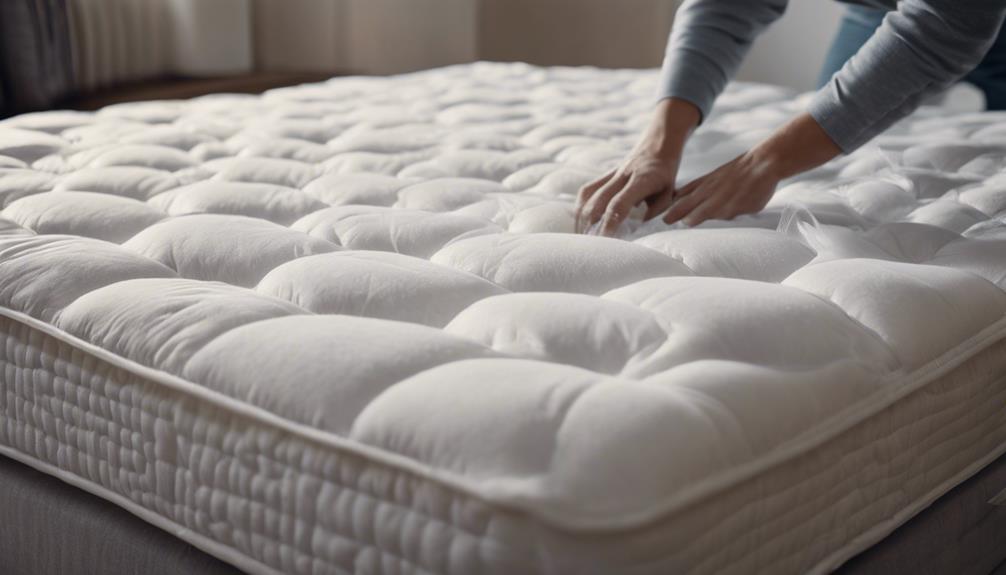
When washing a heated mattress pad, it's important to disconnect the controller and electrical parts beforehand to prevent any potential damage. To clean the pad effectively, use a gentle cycle with cold water in a front load washer. This guarantees that the delicate heating elements aren't compromised during the cleaning process. Avoid using bleach or fabric softeners as these can harm the pad's functionality. Once the washing cycle is complete, it's best to air dry the mattress pad or tumble dry on low heat to maintain its integrity.
Specific cleaning instructions provided by the manufacturer, especially for Sunbeam pads, should be followed meticulously to sustain the longevity of the heated mattress pad. These instructions are tailored to the specific materials and components used in the pad, making them essential for proper maintenance. By adhering to these guidelines, you can keep your heated mattress pad clean and in excellent condition for a comfortable night's sleep.
Detaching Electric Cord Before Washing
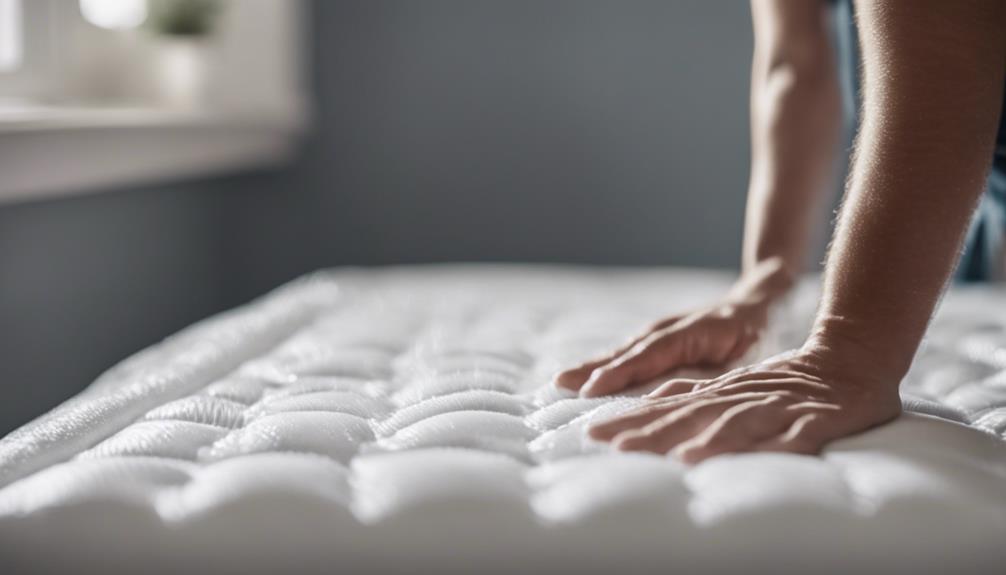
Before washing a heated mattress pad, we must always remember to detach the electric cord. This essential step guarantees cord safety during the washing process and prevents potential hazards.
Cord Safety During Washing
To guarantee safety and prevent damage, always detach the electric cord from the heated mattress pad before washing.
Washing the pad with the cord attached can lead to safety hazards and damage to the electrical components. By disconnecting the cord, you make sure it remains dry and intact during the washing process.
Failure to detach the cord before washing can result in malfunction or electrical hazards. Following proper cord safety guidelines during washing helps maintain the longevity and functionality of the heated mattress pad.
Detaching for Electrical Safety
For best safety and maintenance of your heated mattress pad, it's essential to detach the electric cord before washing. Disconnecting the electric cord before cleaning helps prevent electrical hazards and safeguards the heating elements within the pad.
By separating the electrical components from the pad, you reduce the risk of damage and guarantee a safe washing process. This step is pivotal for maintaining the longevity and efficiency of your heated mattress pad.
Avoid any potential accidents by making sure that the electric cord is detached before initiating the washing cycle. Prioritizing electrical safety during cleaning won't only protect your mattress pad but also create a hassle-free experience when caring for your bedding.
Using Gentle Detergent for Washing
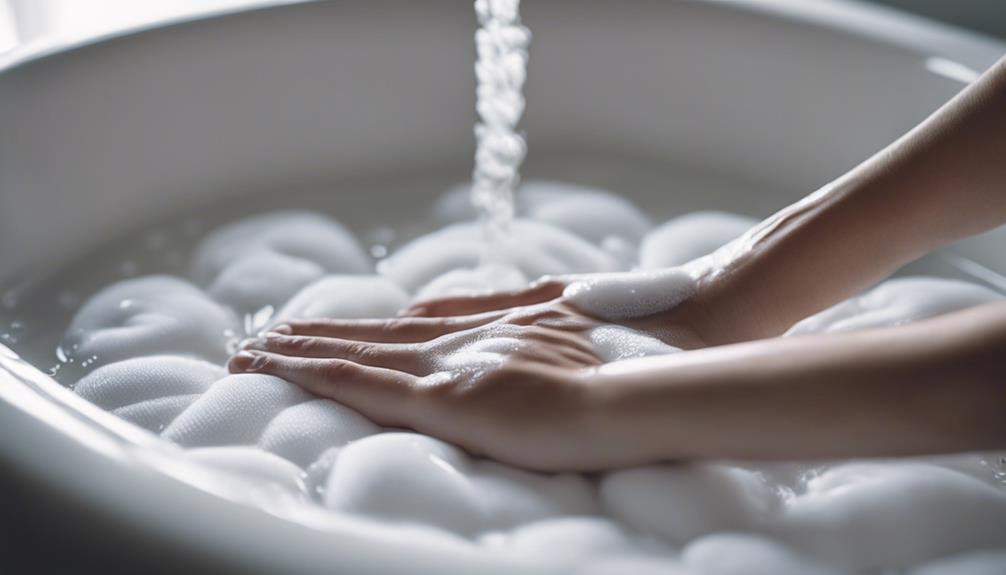
When washing your heated mattress pad, it's important to choose a mild detergent that's gentle on delicate fabrics. This helps to protect the heating elements and maintain the pad's integrity.
Additionally, opting for a detergent suitable for cold water washing can prevent any potential damage to the pad.
Proper Detergent Selection
We recommend selecting a gentle detergent designed for delicate fabrics when washing your heated mattress pad. Using harsh detergents can damage the heating elements of the pad, affecting its functionality. Gentle detergents are essential for maintaining the fabric's integrity during the cleaning process.
Look for detergents specifically labeled as suitable for sensitive fabrics or wool to prevent any potential damage. Choosing the right detergent is important in ensuring the quality and longevity of your heated mattress pad. By opting for a gentle detergent, you can effectively clean your pad without risking harm to the fabric or the heating elements.
Always follow the manufacturer's instructions and guidelines for the best washing practices to keep your heated mattress pad in excellent condition.
Washing Temperature Considerations
Given the delicate nature of heated mattress pads, it's vital to wash them in cold water to safeguard the internal wiring while using a gentle detergent for best cleaning results.
Washing your heated mattress pad in cold water helps prevent any damage to the internal wiring that could occur with warmer temperatures. Additionally, using a gentle detergent guarantees that harsh chemicals are avoided, which could potentially affect the heating elements of the pad.
Washing the Pad Separately
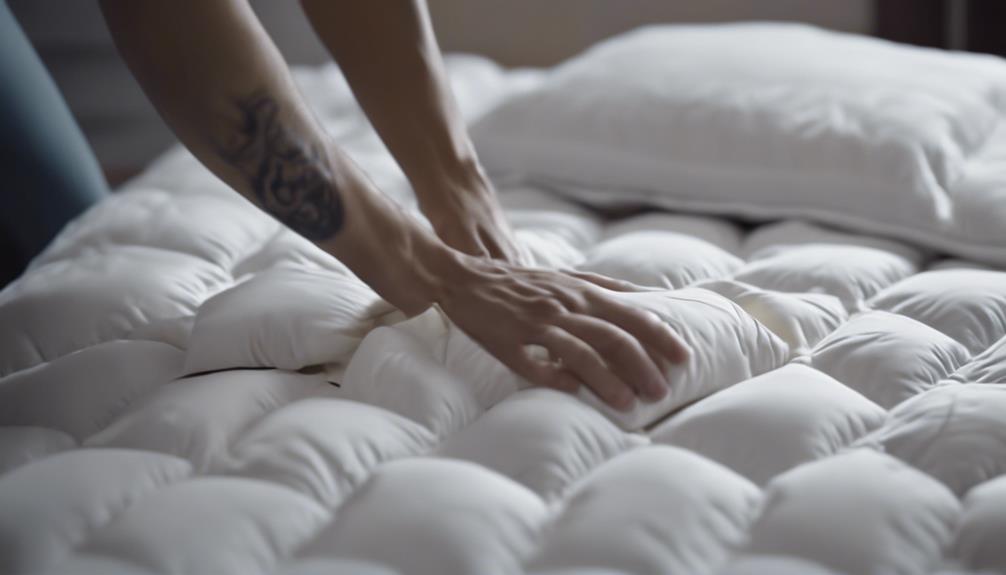
To maintain the quality and safety of your heated mattress pad, always wash it separately from other bedding items. When it comes to washing heated pads, it's important to follow the manufacturer's guidelines for the best results.
Before washing, remember to disconnect all electrical components to prevent damage and guarantee safety. Use a gentle detergent and cold water to clean the mattress pad effectively without compromising its functionality.
Make sure to dry the mattress pad thoroughly before reattaching any electrical components and placing it back on the bed. By washing the pad separately, you can prevent potential damage that could occur if it were washed with other bedding items.
This simple step can help prolong the lifespan of your heated mattress pad and ensure that it continues to provide you with warmth and comfort night after night.
Air Drying in Well-Ventilated Area
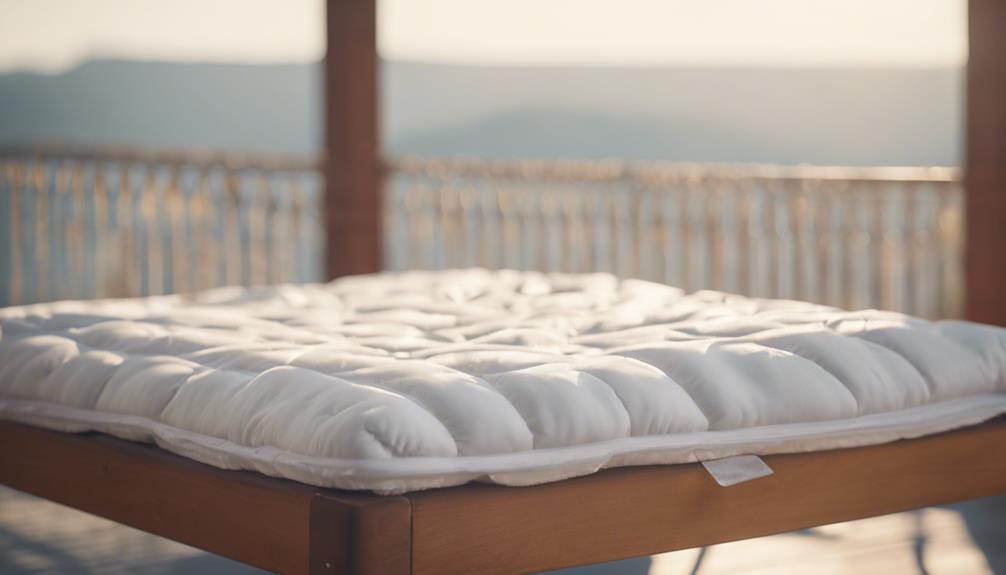
Air-drying the heated mattress pad in a well-ventilated area is essential to prevent damage to its electrical components. Here are some key points to keep in mind:
- Preventing Damage: Proper air drying guarantees that the electrical components of the heated mattress pad aren't compromised, extending its lifespan.
- Thorough Drying: Hanging the pad in a well-ventilated space allows for adequate airflow, ensuring that all parts of the pad dry completely.
- Indoor Drying: If outdoor drying isn't feasible, indoor drying over a shower curtain rod can be a suitable alternative to make sure the pad dries effectively.
- Avoiding Moisture: Storing or using a damp or wet heated mattress pad can lead to mold or mildew growth, which can be detrimental to both the pad and your health.
Guidelines for Maintaining Longevity
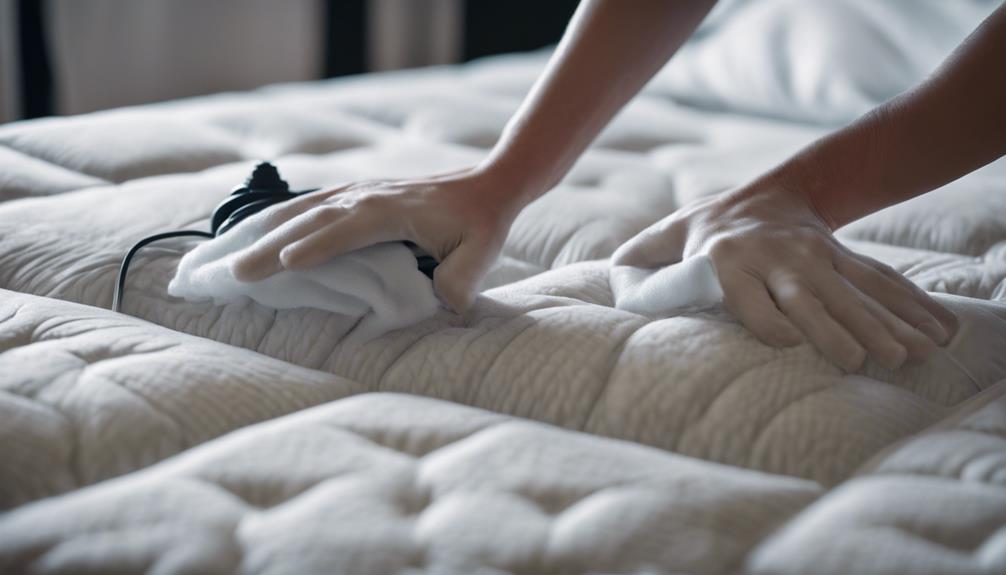
After making sure the heated mattress pad is thoroughly air-dried, the next step to maintaining its longevity involves following specific guidelines for washing and care.
When it comes to cleaning your mattress pad, use a front load washer on a gentle cycle with cold water. It's essential to disconnect the controller and electrical parts before washing to prevent any damage. Remember to avoid using bleach or fabric softeners as they can impact the quality of the pad over time. Opt for a mild detergent instead.
Once the washing cycle is complete, choose to air dry the pad or tumble dry on a low heat setting to ensure proper drying without causing any harm. Additionally, checking the manufacturer's specific cleaning instructions, especially for Sunbeam pads, can provide the best results in maintaining the longevity of your heated mattress pad.
Ensuring Safety During Washing
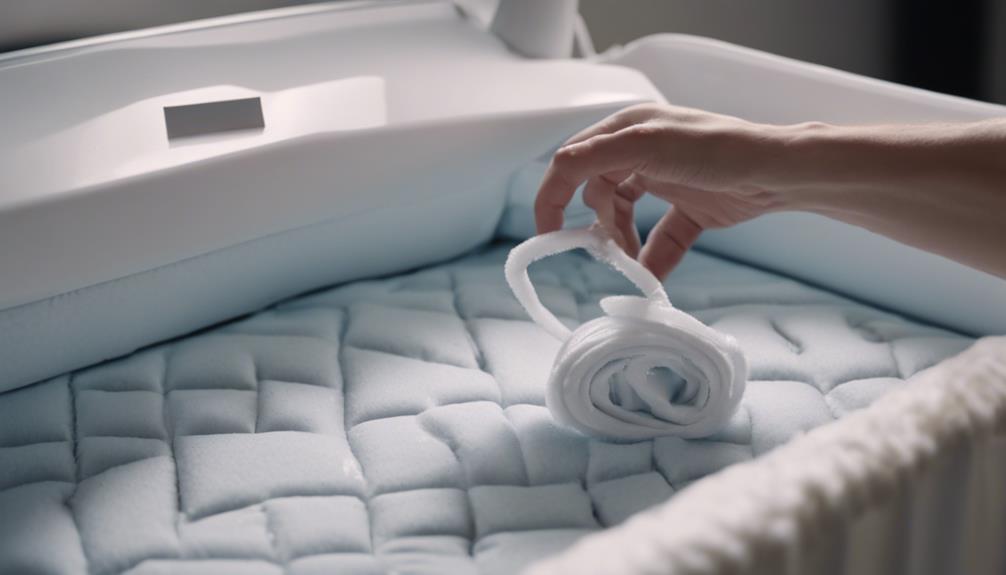
Before commencing the washing process, make sure all electrical components, including the controller, are disconnected to prevent any potential damage. When washing your heated mattress pad, safety should be a top priority. Here are some essential safety precautions to follow:
- Disconnect Controller: Always unplug the controller and detach all electrical parts before washing to avoid any harm to the pad's components.
- Use Gentle Cycle: Opt for a gentle cycle with cold water in a front load washer to maintain the integrity of the pad's material and heating elements.
- Avoid Harsh Chemicals: Refrain from using bleach or fabric softeners as they can cause deterioration of the pad's material over time.
- Proper Drying: After washing, air dry the pad or tumble dry on low heat to guarantee it dries thoroughly without damaging the heating elements.
Importance of Following Manufacturer's Instructions
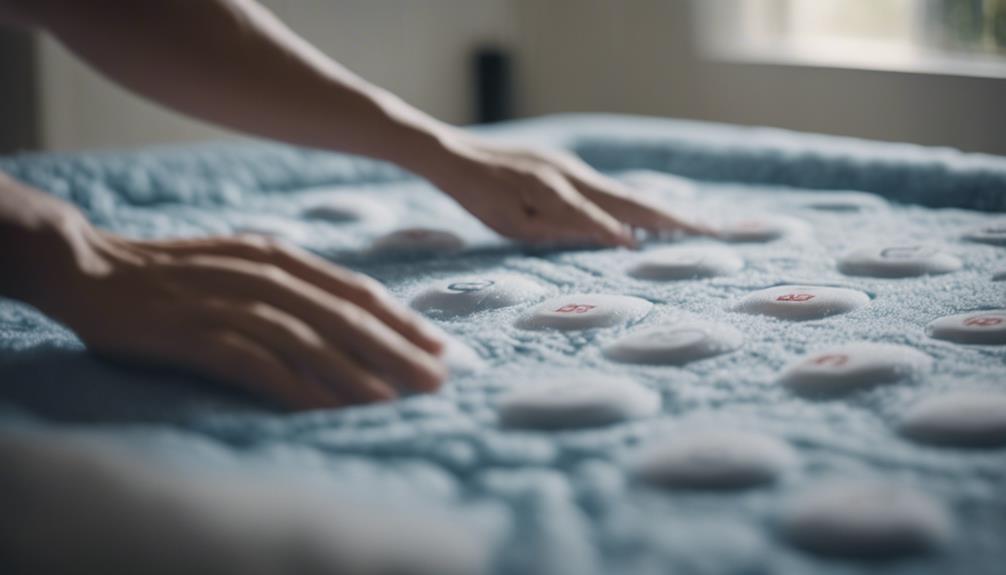
To guarantee the proper care of your heated mattress pad, it's essential to closely follow the manufacturer's instructions for washing and maintenance. Heating pads contain delicate wiring and heating elements that can be damaged if not cleaned properly. By adhering to the manufacturer's guidelines, you can prevent electrical malfunctions and safety hazards that may arise from incorrect washing methods. These instructions often include specific details on suitable washing methods, recommended detergents, and appropriate drying methods to ensure the longevity and safety of your heated mattress pad.
Failure to follow the manufacturer's instructions may not only compromise the effectiveness of the heating pad but also void its warranty. Using the wrong detergents, washing at incorrect temperatures, or employing improper drying methods can lead to irreparable damage. Remember, the manufacturer's recommendations are designed to help you maintain your heated mattress pad's quality and performance while ensuring safety during use. By following these instructions diligently, you can enjoy a clean and well-functioning heated mattress pad for a long time.
Tips for Hygienic Sleep Experience

Maintaining a hygienic sleep experience involves regularly cleaning your heated mattress pad to guarantee cleanliness and longevity. Here are some tips to ensure a clean and cozy sleep environment:
- Spot Cleaning: Use a laundry stain remover or detergent to spot clean dirt and stains without soaking the entire mattress pad.
- Machine Washing: Before washing, check for exposed wires, and detach the electric cord. Wash the mattress pad with a gentle detergent following the manufacturer's instructions.
- Drying Techniques: Proper drying is essential for longevity. Hang the pad in a well-ventilated area to prevent damage and ensure thorough drying.
- Overcoming Cleaning Challenges: By following safe practices, you can maintain a hygienic sleep environment without compromising the benefits of your heated mattress pad.
Frequently Asked Questions
Can You Wash Electric Heating Pads?
Yes, we can wash electric heating pads. Following the manufacturer's instructions is key.
Hand washing or using a delicate cycle with mild detergent is recommended. Remember to disconnect power cords and controllers before washing to prevent damage. Avoid bleach, fabric softeners, or dry cleaning methods.
Proper drying, like air drying in a well-ventilated space, is essential for maintaining the heating pad's integrity.
How Do You Wash a Mattress Pad in the Washing Machine?
We wash a mattress pad in the washing machine by following specific steps.
Disconnect the electrical components, use cold water, and a mild detergent. Avoid bleach and fabric softeners.
Air dry or tumble dry on low heat.
An example involves washing a soiled mattress pad to maintain hygiene and prolong its lifespan.
Following these steps guarantees the mattress pad stays clean and in good condition for future use.
What Is the Life Expectancy of a Heated Mattress Pad?
Heated mattress pads typically last around 5 to 10 years with proper care. Factors like usage frequency and adherence to cleaning instructions can impact longevity. Regular cleaning and following manufacturer guidelines can prolong the pad's life.
Over time, wear and tear from constant use or improper care may reduce effectiveness. Investing in a high-quality pad and maintaining it well can guarantee a longer lifespan and continued comfort.
Can I Wash My Beautyrest Heated Mattress Pad?
Yes, we can wash our Beautyrest heated mattress pad. To do so, we need to detach the controller and power cord first.
Then, using a front load washer and gentle detergent on a delicate cycle, we can clean the pad. It's important to avoid bleach and fabric softeners.
Conclusion
To sum up, washing your heated mattress pad is a straightforward task that can help maintain its cleanliness and longevity.
While some may worry about the safety of washing an electric bedding item, following the manufacturer's instructions and detaching the cord beforehand guarantees a safe and effective cleaning process.
By taking these precautions, you can enjoy a hygienic sleep experience and guarantee your heated mattress pad stays in top condition for years to come.
Mason – Your Product Expert Mason is your go-to product expert, carefully selecting each item in our collection to ensure it meets your comfort, functionality, and style needs. With his attention to detail and commitment to quality, he ensures that every product we offer enhances your home experience.
-
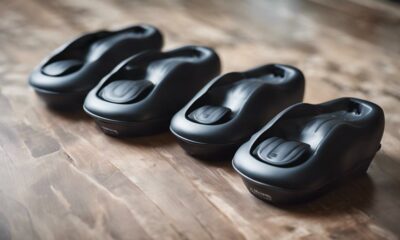
 Vetted8 months ago
Vetted8 months ago15 Best EMS Foot Massagers for Neuropathy to Soothe Your Feet
-
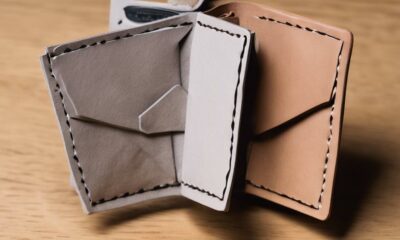
 Vetted7 months ago
Vetted7 months ago14 Best Personalized Father's Day Gifts for Your Husband – Show Him You Care
-

 Alfresco7 months ago
Alfresco7 months agoAlfresco Stacker Doors: Seamless Indoor-Outdoor Living!
-

 Tableware and Dining Accessories2 weeks ago
Tableware and Dining Accessories2 weeks agoWhat Is the Meaning of the Word Tableware
-

 Tableware and Dining Accessories2 weeks ago
Tableware and Dining Accessories2 weeks agoWhen Is Tableware on Sale at Hobby Lobby
-

 Tableware and Dining Accessories2 weeks ago
Tableware and Dining Accessories2 weeks agoWhich of the Following Is Not Classified as Tableware
-

 Vetted2 days ago
Vetted2 days ago15 Best Detergents for Wool: Keep Your Woolens Looking Fresh and Fabulous
-

 Craft and Textiles4 days ago
Craft and Textiles4 days ago15 Best Places to Buy Appliances for Your Home – Top Retailers Reviewed










